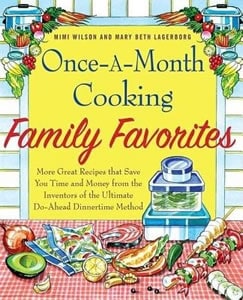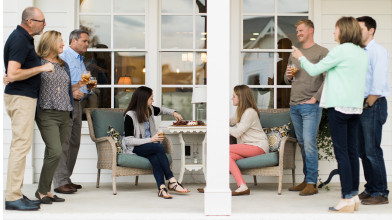Woman: One of my favorite home meals growing up, we had tacos. And we would sit around the table, eat together as a family. Um, and after, we would usually play cards all together and it would get real competitive.
Man: So family meals became a little complicated when my younger daughter became a vegetarian. So we discovered we all like fish. So sushi and salmon are favorite family meals.
John Fuller: Oh my, that makes me hungry. Uh, you know, the question, “What’s for dinner,” can often bring feelings of dread to my wife. She sometimes just freezes, like, “I don’t know. There’s gotta be something here.”
Jim: (laughs).
John: So maybe you’ve experienced that. Uh, if so, you’re gonna enjoy today’s conversation on Focus on the Family with Jim Daly. I’m John Fuller.
Jim Daly: John, today we’re gonna look back on a classic program, all about saving time and money in the kitchen. And who doesn’t want to do that? You mentioned, (laughs) you know, getting ready for dinner. I’m like, all in.
John: Yep.
Jim: How soon? It sounds great.
John: (laughs).
Jim: I imagine you want your family dinnertime to be fun, engaging, and relaxing. Who doesn’t? But maybe you just don’t know how to get there. Uh, we all have busy schedules and it seems like everyone is going in a different direction, especially at dinnertime. Even with, uh, the boys out on their own now, Jean is busy most of the time. And we’re rushing to get to dinner. (laughs) but, uh, we have carved out the dinnertime as the time to be together. And we’ll spend a good hour enjoying our food and talking about things, Usually laughing quite a bit about, you know, those things that happened during the day.
John: Mm-hmm.
Jim: It’s a wonderful time to reconnect and reset a- as a family. And I want to encourage you to do that with your loved ones as often as possible. And our guest today has some great ideas on how to get ahead of the game on the food side, so you have more time to spend on the relational side.
John: Mary Beth Lagerborg is a personal historian, writing memoirs for her clients. And she served as Director of Media for MOPS International for a number of years. Uh, she’s written a number of books, and, uh, the one we’re talking about today is the best-selling Once-A-Month Cooking: Family Favorites, which she wrote with her friend Mimi Wilson. Mary Beth and her husband Alex reside in Colorado and they have three married sons and five grandchildren. Get a copy of the great book Once-A-Month Cooking and find out more about our guests at focusonthefamily.com/broadcast. Let’s go ahead and hear now that classic conversation now with Mary Beth Lagerborg.
Jim: Mary Beth, before we talk about cooking, let’s talk about why we cook.
Mary Beth Lagerborg: Sure.
Jim: Food; it’s interesting that God wired us the way He did, isn’t it? That He created hunger in us so that we have, uh, this need to get together, cooperate, and to eat, hopefully, together.
Mary Beth: Yes, and then food is so often associated with people gathering together, whether it’s a family meal or you want to get together with a friend, so you go out to coffee, you go out for dinner, you have them into your home. It’s just a real connecting place as well. It’s something we have to do regularly.
Jim: Hm. And you started, uh, many years ago with this concept of once-a-month-cooking, which, uh, for those of you who are not familiar with it, that means one day, you cook 30 meals, and, uh, or more.
Mary Beth: Well, or more, or less-
Jim: (laughs).
Mary Beth: … because some people don’t want to cook the whole 30.
Jim: Yeah, some might be overwhelmed.
Mary Beth: But, but you could cook two weeks’ worth.
Jim: Yeah.
Mary Beth: You could cook a week’s worth. But the point is that you’re preparing several entrees at once and freezing them to save your time, than on several days ahead in the late afternoon.
Jim: Now, your co-author, Mimi Wilson, who couldn’t be with us today, uh, how did you get started? Where did you get the idea?
Mary Beth: (laughs).
Jim: Were you guys just frantic about this? How, how were you talking about the problem?
Mary Beth: No, uh, Mimi and I had been good friends for many years. We’d been doing some freelance writing together in the early ’80s. We each had three young children. Mimi has a gift for hospitality, and I, I can’t overstate that. But she called me one day and she said, “I’ve just had prepared 30 entrees and frozen them, would you like to call The Denver Post and see if they want an article?” And I thought she was crazy.
Jim: (laughs).
Mary Beth: I really did.
Jim: (laughs).
Mary Beth: I said, “Mimi, why don’t you call The Denver Post?”
Jim: (laughs).
Mary Beth: And she did, and they sent a reporter and a photographer to her home to do a food feature on what we called The Method. And that got us started because it was publicized, and then people would call her to learn how to do it. And so we eventually wrote it up, and one thing led to another.
Jim: Wow. So what is the benefit of once-a-month cooking?
Mary Beth: The benefit is to use the time and make the mess and prepare several entrees at once, and then your time is freed up in the late afternoon for several days after that to carpool the kids or, uh, do any number of things. In fact, Mimi called me this week. She said, “From the vantage point of many years into this, I’m so thankful for all the time that we had around the table, and also all the time that I saved to do so many other things-
Jim: Mm.
Mary Beth: … instead of cooking from scratch every day.”
Jim: Have you ever looked at that comparison? If you look at the traditional way a, a meal is prepared over a month for 30 days, how many hours go into that, the prep, the shopping for it? And then when you do it all in one day, or maybe two days, uh, how much time do you really save?
Mary Beth: You know, we have never done that. And it would vary a lot from person to person. However, I think as well as the time savings, there’s the stress saving. I mean, you were saying, John, that terrible nagging, “What are we gonna have for dinner?” You know, to do away with that, so that you can get up in the morning, you decide what you’re gonna thaw, you prepare something to go with it, and it’s such a stress-saver. So it’s time plus the stress. And actually, plus the money. Because you can save a lot of money buying in quantity and preparing that way.
John: And Jim, I would think if it were me cooking, would save hundreds of hours, uh, because I’m just so inefficient in the kitchen.
Jim: Freezing hot dogs? Is that what you’re talking about?
Mary Beth: Ah.
John: (laughs).
Jim: You’d cook a hot dog, freeze it?
John: Yeah, totally, yeah. (laughs).
Jim: (laughs). You might be a good cook, John. I don’t know.
John: You’ll, you’ll never know, I guess.
Jim: That’s right. Mary Beth, uh, when you look at that, of course, you have the cost savings, you’re, uh, efficient, so would a person, uh, man or woman, or a couple, uh, do this on a Saturday? Do you just pull together and say-
Mary Beth: Oh, boy, they-
Jim: … today is cooking day.
Mary Beth: … they could do it whenever works, but it’s really important to carve out that time on the schedule because it’s easy to not face it and have it go by. Of course, once you’ve purchased the food, you need to get on with it and do it. But it’s important to look ahead and carve out whatever time works on the calendar and, um, I think you mentioned a husband and wife. It’s great thing to do with a spouse, with a friend, with a child, it’s good to have a companion, it goes a lot quicker, you have someone to talk to, it just flows better when you’re doing it with someone.
Jim: Describe it for us, so we can get our hands around it.
Mary Beth: Sure.
Jim: Uh, what would it look like, typically? You go shopping, you’re getting, uh, a lot of bulk items.
Mary Beth: You’re getting a lot of bulk items. You would not shop on the same day. That’s an energy issue a- and time. You would shop the day before, the evening before, if you do use the book, Once-A-Month Cooking: Family Favorites, there’s a well-prepared shopping list for you and you would choose which menu from there you want to use. You do your shopping and then the next day, there’s an assembly order that takes you step-by-step. You don’t have to be well-organized to do this. And you also don’t have to be a good cook because we’ll take you by the hand and say, “Okay, do this and then this and then this.” And the secret of it is that you’re going to be doing all similar processes at once. You’re going to brown the ground beef all at once. You’re going to do a lot of cooking the chicken and dicing it at the same time. You’re going to chop all those onions at once. And if you think about it, how many times do you do that sort of thing over the course of a month? You’re going to get that over with at once.
Jim: Mm. And-
Mary Beth: And then you assemble the dishes one after another after another. The chicken dish is one after another, the beef dishes, there will be some meatless dishes, and label them and put them in your freezer.
John: Now, these are entrees only?
Mary Beth: Yes, these are the entrees only. And our thought is that if you do that, if you have the entrée ready which is the bulk of the work-
John: Mm-hmm.
Mary Beth: … then you have a little more time to maybe do a fresh vegetable. Perhaps you want to do a dessert, bake some bread, make a salad. But you have a little more time for that.
Jim: Uh, Mary Beth, as you have done this for many years now, I would think, uh, especially with a two-income family, that this methodology is extremely helpful for them, because it does allow them more time around the table, takes the stress out, Mom or Dad can actually relax and be with the family, not be pre-occupied.
Mary Beth: Absolutely. Absolutely. And also, it’s easy for someone, maybe even a little older child to take whatever it is out of the freezer and have it ready when Mom and Dad get home from work. But the point is to gather the family for some significant time together for dinner.
Jim: Mm-hmm.
Mary Beth: I mean, that’s the bottom line there. And so for a working couple, that’d be very helpful.
John: And Jim, that’s something we’re, uh, really encouraging families to do here at Focus on the Family every day to really make an impact on your family dynamic and improve your family relationships. Having dinner together is one of them. That’s something that a lot of families have just sort of let slide away.
Jim: Oh, John, they really have, and, uh, it’s something we need to put an exclamation point on because so many people, uh, write to Focus on the Family saying, “My family seems to be falling apart. What can I do?” And there’s no silver bullet. We know that. But one of the things research is telling us and has shown is that when you eat together, child particularly, are at far less for dangerous behavior, getting involved with drugs and alcohol-
John: Mm-hmm.
Jim: … and other things that will really cripple their development. It seems that, uh, closeness at the dinner table brings kids particularly, uh, into a relationship with their parents where they can talk about the issues of the day. And it allows the parent to really mentor the child and help them in their behavioral development. I’m sure it’s not the cheeseburgers or the pizza or whatever you’re eating. It’s the conversation-
John: Yeah.
Jim: … and the closeness. And it is fascinating research, John. And if there’s one thing you can do to minimize those at risk behaviors for your kids, it’s eat dinner together four or five times a week. You’ll be amazed at the closeness that, that develops in your family. And today, we’re talking with Mary Beth, of course, about how to make that simple with once-a-month cooking. Uh, Mary Beth, if you’re preparing 30 meals for a month, that’s a lot of cooking. Uh, how many hours would you put into getting 30 meals prepared?
Mary Beth: I would put probably eight hours. I would put the whole day into it, but (laughs) those are 30 entrees, 30 meals, and it will be if you space it out over the month, you’re still going to save a lot of time.
Jim: Mm.
Mary Beth: But it’s important to plan on it taking the whole day so you’re not frustrated by it because you could be in the middle and you’ve committed to run a carpool or something and have to stop and start again, that’s difficult. So it’s important to commit the whole day. Of course, it’d be less if you’re a cooking a couple of weeks’ worth rather than the whole month.
Jim: Mm. (laughs).
John: Speak to the person who is not particularly confident about their kitchen skills and, and talk to some of those barriers: kids, uh, a lack of, of confidence. What can they do here?
Mary Beth: One thing to do is to do it with a friend because, um, you can raise your confidence level and also not take (laughs) yourself too seriously, I think, and have fun with it. You might not want to do it with a young child the first time out of the shoot with this method-
Jim: (laughs).
Mary Beth: … if you’re not very confident about it.
Jim: Could be some conflict there.
John: (laughs).
Mary Beth: Well, yeah, and a lot of frustration. But maybe-
John: After, after you get it down.
Mary Beth: … a second or third time. And I don’t think I would tackle the whole month’s worth if I was doing it with a child. I think maybe a week’s worth or, or two weeks, kind of hone it down a little bit.
Jim: Sure.
John: Mm.
Mary Beth: And I, I think too that you can’t get discouraged with the process going back to the importance of that regular meal time together. We all know that not every night is golden. I mean, we all have dinners that just fall apart.
John: Mm-hmm.
Mary Beth: There’s an argument or nobody likes what you’ve prepared or everybody’s in a bad mood, and you can’t let those times get you down because the thing is if you’re intentional about the importance of a regular dinner time, over the course of time, it’s going to be a positive.
John: Mm-hmm.
Jim: Mm-hmm.
Mary Beth: It’s going to be important.
Jim: Uh, talk about some of the meals that you would prepare, because obviously as an eater of those meals-
John: (laughs).
Jim: … I don’t know about you, John-
John: Totally.
Jim: … but how’s the quality and what would you make?
Mary Beth: Oh, in Once-A-Month Cooking?
Jim: Yes.
Mary Beth: Well, first of all, we do not, uh, do only casseroles. I think-
John: (laughs).
Jim: (laughs).
Mary Beth: … people could have that misconception and my family would not just eat casseroles. So there’s a lot of variety. Um, we have a beef pot roast, we have Texas lasagna, uh, chicken packets, that’s a real popular one with kids. We have a marinated flank steak. We have… Each cycle has a, an egg casserole that could be a Sunday morning breakfast or brunch kind of thing. There’s just a wide variety of dishes-
Jim: So you don’t have to give up your palate to do this.
Mary Beth: … Asian dishes, Mexican… Oh, no, not at all. We really have worked on getting a wide variety of recipes in these books, but also ones that a family would eat. Because there’s no sense buying this quantity of food and then not having a family perhaps with some picky eaters among the kids not like it.
Jim: Sure. Yeah. Mary Beth, uh, I’m thinking also of, and perhaps even a single mom or single dad and maybe they’re stretched financially, is it hard to, to do this if you don’t have a little bit of extra? Can you-
Mary Beth: Well, you do-
Jim: … get it done?
Mary Beth: You do need to plan for that cooking day because you’re going to be spending a good portion of your grocery money at one time-
Jim: Mm-hmm.
Mary Beth: … to buy the food for the entrees, there will be very little waste to it, you’re going to save money by not having to resort to eating out, getting fast food, ordering in pizza. All of those events are more expensive.
Jim: Mm-hmm.
Mary Beth: So, you are going to save money. It takes a little planning upfront to have a little extra set aside in one lump-
Jim: Right. So-
Mary Beth: … to do your cooking.
Jim: … again, you could start smaller, start with a week or two weeks-
Mary Beth: Right.
Jim: … before you get to a month.
John: And I’m wondering if you need to go out and buy a deep freeze for all this. I mean, it’s… It sounds like I’m going to come home with… Well, we have a lot of kids, so I’m going to come home with, you know, five or six chickens and, uh, and a, and a bunch of ground beef. Where am I going to put all that stuff?
Mary Beth: Well, I have never had a big freezer myself. Never. And you can do it with just your refrigerator freezer if you clean it out before your cooking day.
John: All right.
Mary Beth: If you throw those hard little nots of things you threw in there-
John: And get rid of the ice cream and all that stuff.
Mary Beth: Yeah. You don’t have room for ice cream and all at first, but over the course of the month, as you’re using up the entrees, you do. I have an old, what was our old refrigerator freezer combination in our laundry room.
John: Mm-hmm.
Mary Beth: So, I will use that, but it is-
Jim: So, you don’t need to deep freeze.
Mary Beth: … possible. You don’t need a deep freeze, no. And, you know, it’s because a lot of the packaging is done in freezer bags as well that you can smash flat and put on the door and that sort of thing.
Jim: Mm.
John: We’re hearing some great advice from Mary Beth Lagerborg, the author- co-author actually with Mimi Wilson of the book Once-A-Month Cooking: Family Favorites and, uh, I’m intrigued Jim by this whole concept here. Uh, this is something as, as we said earlier that Focus on the Family has, uh, a real interest in as we try to promote, uh, the, the sense of families having dinner together. This seems like a great tool to, uh, to be able to lean on so you can be prepared for having a meaningful dinnertime together.
Jim: Well, John, good ideas don’t grow old, and this is something, uh, Mary Beth, we had you here at Focus on the Family back in the early 90s to talk about this concept and I think thousands of people have taken advantage of this and have, uh, especially when you have kids at home. I mean, obviously, that’s a time when time pressure is especially tense, so to be able to cook your meals all in one day for a month is a very good way to, uh, save your time and to be able to spend it in a way that you want to.
Mary Beth: Mimi and I have been delighted to see how many different applications there are for this as well. For example, if you are doing once-a-month cooking and you have an elderly parent. You could package a portion of each of the dishes and take it to that parent’s home and have it in the freezer. You have meals on hand to give to people-
Jim: Mm-hmm.
Mary Beth: … friends or family who are in need. It’s, it’s an easy thing to provide a meal.
Jim: Now, why, uh, Mary Beth, why is this so novel? I mean, with all the benefits that it saves money, it saves time, it’s efficient, it gives you time at the dinnertime to be able to spend with your family as opposed to, you know, cooking over a hot stove. Uh, why do people not just do this?
Mary Beth: Well, I think there’s a, a component that’s important which is being intentional about mealtime, and looking forward and doing some planning ahead. Because this is a system that if you’re really interested in planning ahead for meals, you’re probably going to have your antenna up and be into this. And there are a number of people quite frankly who do this in a franchise setting, go to a storefront, uh, Supper Solutions or different ones and do it that way, don’t want to do it in their own kitchens necessarily. That’s going to be a little more costly.
Jim: Uh, Mary Beth, I’m not, uh, familiar with Supper Solutions. What is that?
Mary Beth: Well, Dream Dinners, Supper Solutions are businesses where… Actually, they’re using a method identical to once-a-month cooking, but you would go in and you would walk to various stations where the ingredients were there to just assemble the different entrees and you package them and you walk out ready to put these in your freezer.
Jim: Oh, okay.
John: Is it a place where you go and cook the food or you go and get this, the ingredients so you can go home and cook the food?
Mary Beth: Uh, some of it would be already cooked, you would gather the ingredients, you would assemble it. I think that would be the word-
Jim: Freezer ready.
John: Okay.
Mary Beth: … and put it-
Jim: You like that?
John: That’s right.
Mary Beth: That’s perfect.
Jim: I’m learning!
John: (laughs).
Jim: Don’t tell Jean.
John: (laughs).
Jim: Don’t tell Jean about this. Uh, Mary Beth, let me also ask you a question about people with special diets. Uh, you know, in our country there seems to be a lot of dietary needs for different reasons we have restrictions: diabetes, other kinds of things. Uh, do people that have special dietary needs, is this still an easy approach for them?
Mary Beth: What we’ve found is that it works very well for a family where perhaps one family member has a special dietary need, so that you’re not preparing two different meals at the same time every evening. For example, you would do once-a-month cooking for the rest of the family if you will, and then it’s a much easier thing to prepare for the person on the special diet. And in the book Once-A-Month Cooking: Family Favorites we do have one two-week cycle that’s entirely gluten-free recipes.
Jim: Oh, great.
Mary Beth: Because that was the greatest request that we had for a specialty menu would be gluten-free.
John: I saw that in the book before we came here in the studio and I was thinking about my, uh, 20-year-old son whose doing a gluten-free diet. And, and he essentially cooks all of his meals separately and, and so he’s really doubling up on efforts that we’re already engage, so I appreciate that perspective. It sounds like a great way that, uh, if he were to join us in once-a-month cooking effort, he could kind of have his stuff over here and at the same time just knock it all out, is that right?
Mary Beth: That would great, yes, he could.
Jim: Now, I’m kind of down to the practicalities. So, I’ve, uh… Jean and I maybe we’ve spent this day, we’ve had our boys helping us and we’ve chopped up all the chicken and we’ve cooked all the ground beef and we’ve mixed in the onions and done everything and we’ve… I guess in little, uh, kind of Tupperware packets or-
Mary Beth: (laughs).
Jim: … Ziplocs? I don’t even know what looks like.
Mary Beth: Ziplocs?
Jim: But we’ve thrown it in the freezer, very carefully.
Mary Beth: Yeah.
Jim: (laughs). And now it’s frozen. Tell me what it’s like at mealtime. I get home tonight, what am I going to do with Jean? I’m going to pull that out of the freezer? What happens next? (laughs).
Mary Beth: Well, you’re probably going to pull it out this morning or somehow you need to thaw it-
Jim: (laughs). Okay.
Mary Beth: … before you-
Jim: This is basic, John.
Mary Beth: … heat it up. Yeah. But you could have like the Texas lasagna, you could have that in the oven then, this evening for probably 35 minutes and meanwhile throw together a salad, perhaps a vegetable and you have dinner ready to go.
John: You throw a, a lot of salads together don’t you, Jim?
Jim: I can actually do that.
John: Can you?
Jim: Yeah, you laugh at me, but-
John: Salads and pancakes all day.
Jim: I could do that.
John: We’re unpacking your portfolio of recipes in kitchen, uh, skills.
Jim: Now, I’m thinking, uh, Jean and I often will have special occasions at the house or something like that. Do, do you have another… a whole section of special occasion meals to feed 10?
Mary Beth: We don’t have (laughs)-
Jim: (laughs).
John: (laughs).
Mary Beth: We don’t have a special section, but in each of the menu plans, there are some dishes that serve between eight and 12 people.
Jim: Uh-huh.
Mary Beth: Because we just assume that people are either going to be having some company. If they’re not, they can divide it in half and freeze it in two containers and do it that way. But we do allow for the eventuality or the hope-
John: Mm.
Mary Beth: … that people will be having company.
Jim: Now, with all of the hope that we’ve been giving people, that this’ll save you time, it’ll save you money, it’ll, uh, allow you more time with the family at the dinner table. What other reason that, uh, failure occurs here? Over the years that you’ve done this when, uh, women have written in to you, or men, saying, “I just couldn’t stick with it.” What would they say?
Mary Beth: They may try to do too much. It does take a lot of energy. If you think about it, cooking is a lot of standing on your feet and a counter and that can be exhausting, and sometimes people will think, uh, they might do a month’s worth whereas really their energy level would be to one of the two-week plans. And so they’ve gotten too tired and think, “Oh, I don’t have the energy to do that again.” Or they just let… It’s easy to let time slip away from us. It really is. And that’s why I said at the beginning it’s important to get that time on the calendar to cook, you’re always glad you’ve done that. But if you don’t, it becomes difficult to take that slice of time and set it aside and do the cooking.
Jim: And Mary Beth, uh, another thing that I caught was the way that you use once-a-month cooking to teach your kids about hospitality. Uh, tell us a little bit about that. Because every… I think every parent wants their children to learn that, to be, uh, uh, gracious toward others and to express hospitality but how does this help them?
Mary Beth: You know, to me that is so important and I think that it’s crucial to keep it on a level as simple as this, just the idea that a warm meal and good conversation are simple, valuable gifts that anybody enjoys. If you don’t try to make it a big production, if you don’t think the house has to be clean, and the meal has to be just right, if I can tell you a little story. When our oldest son was living at home, he was going to school and on the weekends in the winter, he taught snowboarding up in the mountains. One Saturday morning early, he’s going out the door to go up the mountains and I’m standing up at the coffee pot in my bathrobe having a first cup and as he leaves he says, “Oh, Mom, can I bring Joe, a skiing instructor, home for dinner tonight?” And I’m, “Sure, no problem.” As he goes out the door, he says, “Oh, did I tell you Joe used to be a chef?” And the door slams.
John: Oh, my goodness. (laughs).
Mary Beth: So, I’m standing there having my coffee and I know that dinner that night is going to be meatloaf, green beans, and mashed potatoes. And I was pretty proud. I don’t make mashed potatoes very often.
Jim: (laughs).
Mary Beth: And suddenly it didn’t seem good enough. But I had a busy day, oh well, we’re going to have to go with this. So, that evening I hear the two of them come in the back door and this young man, Joe, who is single, probably in his 30s, he goes, “Wow, it smells like a family!”
Jim: Oh, wow.
John: Mm.
Jim: Interesting.
Mary Beth: Didn’t matter what we’re having for dinner.
Jim: Yeah.
Mary Beth: And I think that families, particularly with young children, need to remember that it’s actually an asset to smell like a family, to sound like a family, to look like a family. Don’t worry about getting it all perfect. Lots of people love being embraced being in that family-ness. It’s not perfect, but there’s something to that, that’s special.
Jim: Mary Beth, that is so well said and I think, uh, I think I’m going to try and go home tonight and say to Jean, “Let’s try this, let’s give this a go, once-a-month cooking,” and we’re going to pick up your book Once-A-Month Cooking: Family Favorites and, uh, and apply it. So if we get in trouble, can we just email you or call you?
John: (laughs).
Mary Beth: Uh, sure (laughs).
Jim: (laughs).
Mary Beth: I have had some of those calls over the years (laughs).
John: Do, do you make house calls? Because we’re not that far away. (laughs).
Mary Beth: I wou-… For you, I would make a house call.
Jim: And in fact, John, I think on the website are we, are we going to put a little cooki-… We’re going to do a little cooking right now-
John: That’s the plan, Jim.
Jim: … so that’s going to be on the website as well, we hope, if it comes out right. Is that right? (laughs).
John: Yeah, it, it depends if you carry your weight on this thing or not.
Jim: Well, thank you (laughs).
John: (laughs).
Jim: I can chop onions, without crying.
John: Okay.
Jim: I think.
John: I can’t wait to see that.
Jim: But it’s been great to have you with us Mary Beth. Thank you so much. And, uh, we look forward to having you back on so we can tell you how good it was.
Mary Beth: Thank you. I look forward to it too.
John: Well, what a fun look back at this classic program with Mary Beth Lagerborg and I hope you’ll employ some of her tactics about, uh, cooking for your family. We have her book Once-A-Month Cooking: Family Favorites available here at the ministry. It is full of delicious family-friendly recipes and, uh, has three specialty areas of cooking: gourmet, summertime, and gluten-free. Uh, donate today, a gift of any amount, and we’ll send a copy of Once-A-Month Cooking as our way of saying thank you for supporting the ministry efforts here at Focus on the Family. Join the support team with a monthly pledge or one-time gift and you can find all the contact information at focusonthefamily.com/broadcast. Or give us call. Our number is 800, the letter A, and the word, FAMILY. 800-232-6459. Have a great weekend with your family and your church family as well and plan to join on Monday. We’ll have practical advice for how to read the Bible with your child.
Danika Cooley: Our primary goal is to introduce some of the Scripture, and I think it can be done in 10 or 15 minutes a day, and for us, our strategy has been to make that a part of our rhythm.
John: That’s next time on Focus on the Family. And when you get in touch, please let us you listen on Good News Radio. I’m John Fuller and on behalf of Jim Daly and the entire team, join us next time as we once again help you and your family thrive in Christ.





















